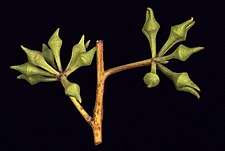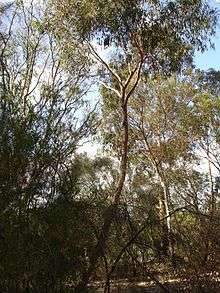Eucalyptus macrorhyncha
Eucalyptus macrorhyncha, commonly known as the red stringybark,[2] is a species of medium-sized tree that is endemic to eastern Australia. It has rough, stringy, grey to brown bark, lance-shaped adult leaves, flower buds in groups of between seven and eleven, white flowers and hemispherical fruit.

| Red stringybark | |
|---|---|
 | |
| Eucalyptus macrorhyncha in Maranoa Gardens | |
| Scientific classification | |
| Kingdom: | Plantae |
| Clade: | Tracheophytes |
| Clade: | Angiosperms |
| Clade: | Eudicots |
| Clade: | Rosids |
| Order: | Myrtales |
| Family: | Myrtaceae |
| Genus: | Eucalyptus |
| Species: | E. macrorhyncha |
| Binomial name | |
| Eucalyptus macrorhyncha | |
| E. macrorhyncha, field distribution | |
Description
Eucalyptus macrorhyncha is a tree that typically grows to a height of 12–35 m (39–115 ft) and forms a lignotuber. It has rough, stringy, grey to reddish brown bark on the trunk and branches. Young plants and coppice regrowth have egg-shaped leaves 25–105 mm (0.98–4.13 in) long and 20–52 mm (0.79–2.05 in) wide. Adult leaves are lance-shaped to curved, the same dull to glossy green colour on both sides, 75–140 mm (3.0–5.5 in) long and 12–38 mm (0.47–1.50 in) wide on a petiole 7–20 mm (0.28–0.79 in) long. The flower buds are arranged in groups of seven, nine or eleven in leaf axils on an unbranched peduncle 7–18 mm (0.28–0.71 in) long, the individual buds on pedicels 4–6 mm (0.16–0.24 in) long. Mature buds are diamond-shaped, 5–9 mm (0.20–0.35 in) long and 4–5 mm (0.16–0.20 in) wide with a beaked operculum. Flowering occurs between February and July and the flowers are white. The fruit is a woody hemispherical or shortened spherical capsule 3–7 mm (0.12–0.28 in) long and 6–12 mm (0.24–0.47 in) wide with the valves protruding above the rim of the fruit.[2][3][4][5]
Near Bundarra and Barraba, this species is difficult to distinguish from E. laevopinea.[3]
Taxonomy and naming
Eucalyptus macrorhyncha was first formally described in 1867 by George Bentham based on specimens collected by Frederick Adamson and by Ferdinand von Mueller who gave the species its name and wrote an unpublished description. The formal description was published in Flora Australiensis.[6][7]
In 1973, Lawrie Johnson and Donald Blaxell changed the name of Eucalyptus cannonii to E. macrorhyncha subsp. cannonii and the names of the two subspecies are accepted by the Australian Plant Census:
Distribution and habitat
Red stringybark occurs on ranges and tablelands of New South Wales, the Australian Capital Territory and Victoria, with a small, disjunct population in the Spring Gully Conservation Park south-west of Clare in South Australia.[2][5][10][11]
Gallery
 leaf
leaf fruit
fruit bark
bark
References
- "Eucalyptus macrorhyncha". Australian Plant Census. Retrieved 22 September 2019.
- Hill, Ken. "Eucalyptus macrorhyncha". Royal Botanic Garden Sydney. Retrieved 22 September 2019.
- "Eucalyptus macrorhyncha subsp. macrorhyncha". Euclid: Centre for Australian National Biodiversity Research. Retrieved 1 June 2020.
- Chippendale, George M. "Eucalyptus macrorhyncha". Australian Biological Resources Study, Department of the Environment and Energy, Canberra. Retrieved 22 September 2019.
- Brooker, M. Ian H.; Slee, Andrew. "Eucalyptus macrorhyncha". Royal Botanic Gardens, Victoria. Retrieved 22 September 2019.
- "Eucalyptus macrocarpa". APNI. Retrieved 22 September 2019.
- Bentham, George; von Mueller, Ferdinand (1867). Flora Australiensis (Volume 3). London: Lovell Reeve & Co. p. 207. Retrieved 22 September 2019.
- "Eucalyptus macrorhyncha subsp. cannonii". Australian Plant Census. Retrieved 22 September 2019.
- "Eucalyptus macrorhyncha subsp. macrorhyncha". Australian Plant Census. Retrieved 22 September 2019.
- "Spring Valley Conservation Park". Australian Government Department of the Environment and Energy. Retrieved 22 September 2019.
- Brooker, M.I.H. & Kleinig, D.A. Field Guide to Eucalyptus, Bloomings, Melbourne 2001
External links
| Wikimedia Commons has media related to Eucalyptus macrorhyncha. |